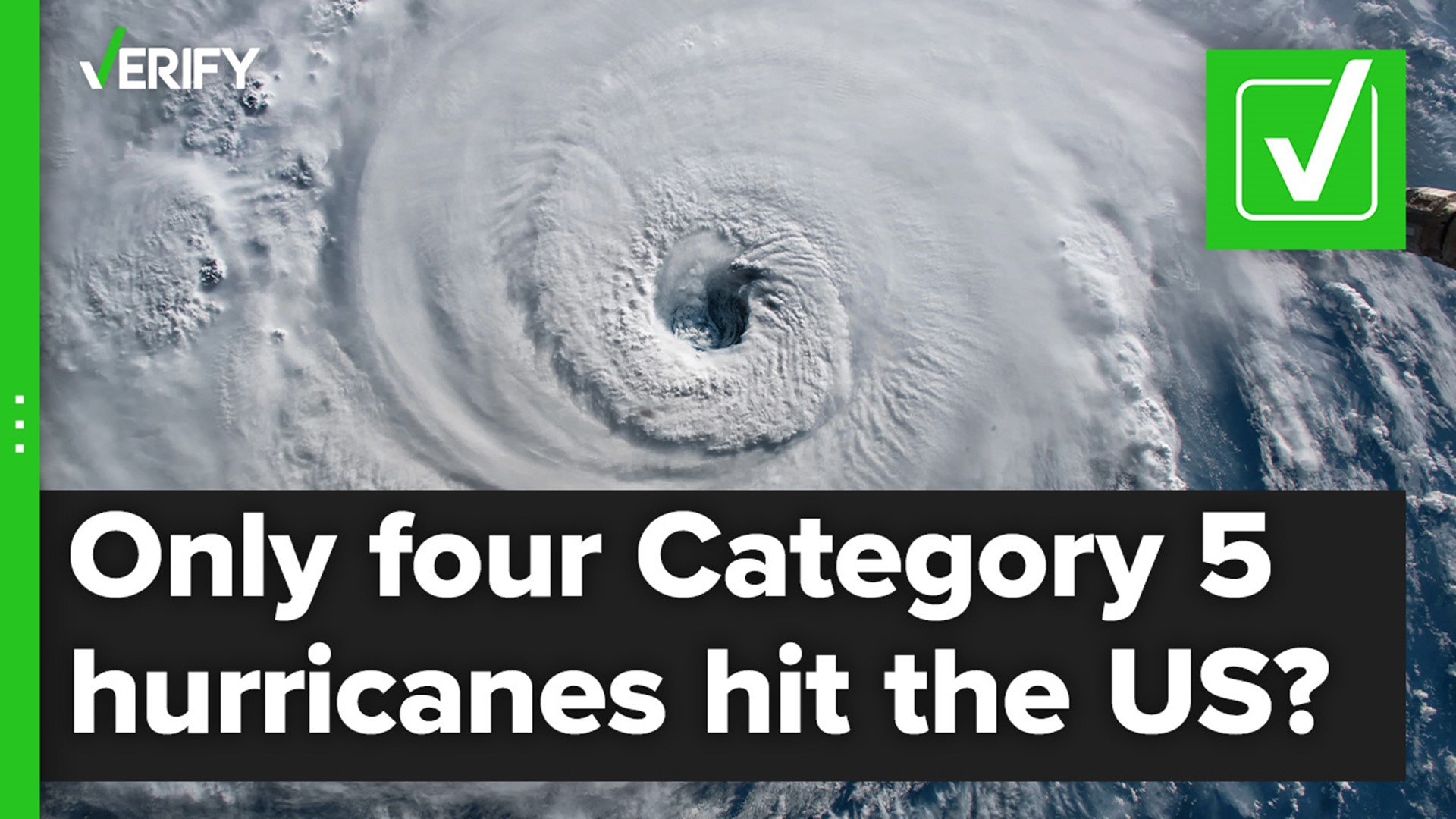As Hurricane Ian approached the western Florida coast on Sept. 28, it peaked in intensity with 155 mph winds, just 2 mph short of reaching Category 5 status. It eventually made landfall with wind speeds of 150 mph.
Before it made landfall, some meteorologists on social media believed Ian had the chance to strengthen into a Category 5 by surpassing wind speeds of 157 mph.
Had Ian reached that strength at the time of landfall, it would have become only the fifth Category 5 ever to make landfall on the mainland U.S. Some people argued that there had to be more than four Category 5 hurricanes to ever hit the U.S. and asked about other devastating hurricanes excluded from the list.
THE QUESTION
Have only four Category 5 hurricanes ever made landfall in the mainland U.S.?
THE SOURCES
THE ANSWER
Yes, only four Category 5 hurricanes have ever made landfall in the mainland U.S.
WHAT WE FOUND
Only four Category 5 hurricanes have ever made landfall in the mainland U.S., according to records from the Hurricane Research Division of the National Oceanic and Atmospheric Administration (NOAA), the Weather Channel and the World Meteorological Organization (WMO).
Those four are the Labor Day Hurricane of 1935, Camille in 1969, Andrew in 1992 and Michael in 2018.
Hurricanes are measured by their sustained surface wind speeds on the Saffir-Simpson Hurricane Wind Scale. This scale does not account for other hurricane hazards such as storm surge and rain. A hurricane’s “sustained wind speed” is the average of a hurricane’s strongest winds over a 1-minute period, the American Meteorological Society says.
NOAA says that a Category 1 hurricane has wind speeds between 74-95 mph, Category 2 hurricanes have wind speeds between 96–110 mph, Category 3 hurricanes have winds between 111–129 mph, Category 4 hurricanes have winds measuring between 130–156 mph and Category 5 hurricane winds blow at a strength of 157 mph or greater.
Neither Andrew nor Michael were initially considered Category 5 hurricanes at landfall. Andrew was considered a Category 4 at landfall for 12 years before NOAA scientists reclassified it as a Category 5 storm at landfall in Nov. 2004 because of improvements in surface wind speed estimations. A NOAA post-storm analysis in April 2019 similarly bumped Michael’s wind speeds at landfall up from Category 4 strength to Category 5 strength because of data not available in real time.
The 1935 Labor Day Hurricane first made landfall in the Florida Keys with an estimated 185 mph wind speed and an air pressure of 892 mb. Both of those numbers are the most intense for any hurricane at the time of landfall in the mainland U.S. It remained within 50 miles of the Florida Gulf Coast until it made its second and final landfall in the state’s Big Bend region as a Category 2 storm.
Hurricane Camille struck the Mississippi coast in 1969 with a sustained wind speed of 175 mph and an air pressure of 900 mb, making it the second strongest hurricane on record to strike the U.S.
Hurricane Andrew made landfall just south of Miami, Florida, while its wind blew at speeds of 165 mph in 1992. The storm continued past Florida and into the Gulf of Mexico, eventually making landfall for the final time in Louisiana while it was still a Category 3 hurricane.
Hurricane Michael strengthened into a Category 5 just before battering the Florida panhandle with 160 mph winds in 2018. The WMO says it was the fourth strongest hurricane to ever make landfall in the U.S.
Yale Climate Connections says this year’s Hurricane Ian was the fifth-strongest hurricane to make landfall in the U.S. after it hit Florida with Category 4, 150 mph winds.
Outside of the mainland U.S., American territories in the Caribbean have also weathered the impacts of Category 5 Atlantic hurricanes.
An unnamed hurricane in 1928 made landfall in Puerto Rico at Category 5 strength. Hurricane Irma and Hurricane Maria devastated the U.S. Virgin Islands with Category 5 winds in 2017, although neither made direct landfall on any of the islands. Maria weakened to a Category 4 before making landfall in Puerto Rico.
Many people today remember Hurricane Katrina as a particularly devastating storm, but it wasn’t a Category 5 when it hit Louisiana. In the last 18 hours before landfall near New Orleans, Hurricane Katrina weakened from a Category 5 hurricane with wind speeds of about 173 mph to a Category 3 hurricane with wind speeds of about 127 mph, NOAA says. Similarly, the Galveston Hurricane of 1900, the deadliest natural disaster in U.S. history, was believed to be a Category 4 storm when it flooded the city with a massive storm surge.
In total, NOAA says only 37 recorded Atlantic hurricanes since 1924 have reached Category 5 wind speeds at some time in their lifetime. All but one of these storms, Lorenzo in 2019, made landfall, but only four maintained Category 5 winds as they came ashore in the mainland U.S.

